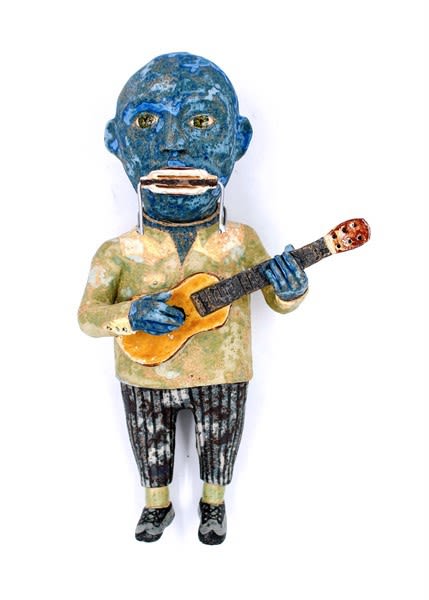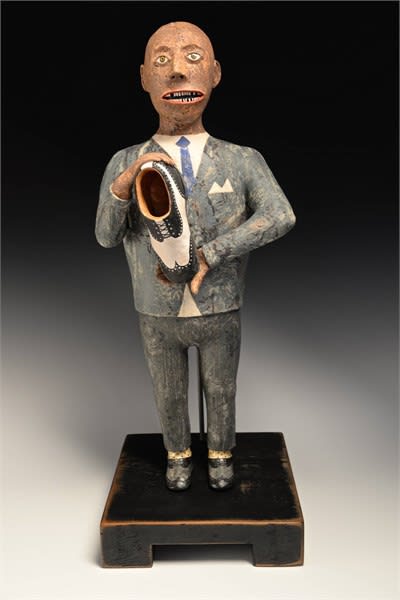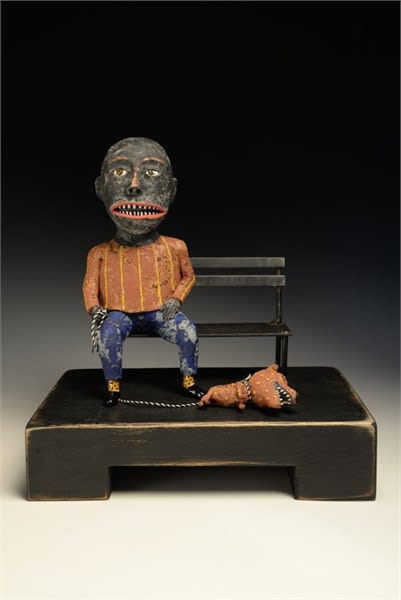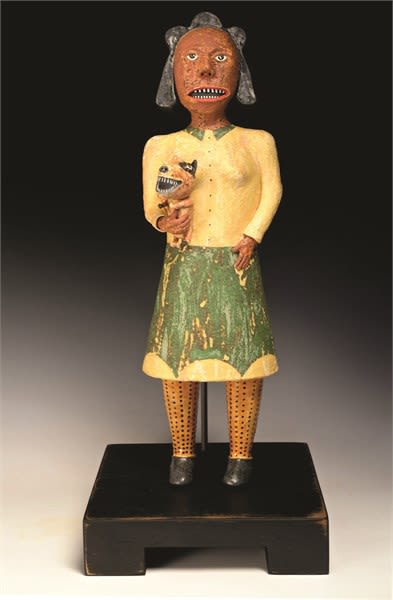
We conducted this interview with California ceramicist Wesley Anderegg for a solo exhibition in 2018. His new exhibition, Critters, debuted in March 2020 and inspired us to dive back into our archives and resurface this in-depth conversation about Anderegg's life and artistic practice.
You could call Wesley Anderegg‘s earthenware figures superheroes, though they’re (mostly) not the kind with masks or capes. Anderegg depicts everyday heroes, and their gap-toothed grins are evidence of their grit. “They’ve been through some hard knocks, but they are survivors, still doing their thing day in and day out,” the California artist says.
Anderegg is originally from Arizona, and started his art career making functional ceramics. He’s a lifelong people watcher, so his subject matter inevitably shifted into the figurative realm. Watch our video interview above, and scroll down to read the full conversation and learn how Anderegg developed his idiosyncratic sculptural style.
JE: Did you make art when you were a kid?
WA: No, I wasn’t an artsy kid. Not at all. I was a baseball player, beer drinker and motorcycle racer growing up.

Wesley Anderegg, Shoe Salesman, ceramic, wood, steel
Do you think growing up in Arizona has influenced your ceramics work?
The desert colors definitely influenced me. My palette is always earthen colors. I don’t go for crazy magenta, it’s just all ochres and red irons and black. That’s more my palette.
So you’ve always resisted using bright colors?
Yep. If it’s too bright, I run the other way. Lemon yellow is not going to happen. I gotta make it ochre, you know?
You studied geology for your undergraduate degree. When did art enter the picture?
I was working on the oil fields up in Wyoming, and I had all of these miserable jobs. My mom said, ‘Why don’t you go to school?’ I said, ‘Sure, sign me up.’ She signed me up and she picked my major, and that was it. She thought I could become a schoolteacher and I’d have a decent job.
I was a junior when I took a ceramics class as an elective, and that was it. I knew. That was the first art class I’d ever had in my whole life. I was petrified going in there, because I thought, ‘Everybody’s going to be so good, and I don’t know anything.’ Everybody was a beginner, so I felt right at home.
Why do you think you fell in love with ceramics so quickly?
I’ve got super good hand-eye coordination, from sports. I’m really good with my hands. The clay, it came easier to me than probably most people. I worked really hard, too. I loved it. I made more work my first semester than the rest of the class combined. I was in there all night, every night of the week, just learning how to throw on the potter’s wheel. I wanted to learn how to do it.

Wesley Anderegg, Man With Sleepy Dog, earthenware
So you graduated with a degree in geology. How did you start your career as an artist?
Every summer, I would go to California and I’d live in my van on the beach. I’d save up $500, and I’d get in my ’65 Volkswagen van and I’d drive it over to California, and I’d live on the streets in my van at the beach. While I was doing that, I realized that I didn’t want any kind of straight job. I didn’t want to be in the mainstream of America.
I thought, ‘If I could just make pots and have a little shack by the beach and maybe sell something here or there, that sounds great.’ When I graduated, I just set up a studio and went to work.
Did you have any reservations about diving straight into it?
I was young and naive. The doubts didn’t even enter my mind. I said, ‘I’m going to make this work, come hell or high water. I’m just going to do this.’ But I also knew that I had to make a product that sold. When I was starting out, I was trying to make stuff that people liked.
I just put all that money away, and after about 7 years I was totally sick of being this little machine and pumping out these pots. So I started making the figurative stuff. I started pinching these little cups with faces on them.
Tell us more about the early figurative work.
When me and my wife first started going out, we would go to the bar and we would drink kamikazes and stuff like that. I started making these shot glasses that had these crazy faces on them and were all bent up. Before that, all I had ever done was throw on the potter’s wheel.
The faces were really ugly, but I kind of liked them ugly. So did everybody else. They were really gnarly, and I was kind of angst-ridden, and I wanted to express my gnarly-isms, you know? People liked them, so I just took off on those. They even had the funky teeth and everything back then. I didn’t want anything cutesy.
At some point after that, I stopped making cups and they became sculpture.

Wesley Anderegg, Lady with Dog, earthenware
Why were the original pieces so grotesque?
I was an angry young man. I had a lot of stuff I wanted to get out. It was therapy, you know? It was a cathartic process to vent all this stuff.
They were autobiographical, and emotionally how I was feeling. How do you explain feeling like you’re being torn apart? You actually tear somebody apart. Or I had people sucking my blood. I would create mosquitoes and ticks, making that reference of people sucking you dry. All these little narratives were filtering through my work.
Were any of them portraits?
Some of them are based on real people, like heroes or interesting folks. A lot of them represent me, but emotionally what I’m doing or going through.
A lot of your figures are in danger!
They often are in peril. That’s what I’m drawn to. I like characters. The beautiful people don’t interest me at all. I like the funky people, and the people that are going to tell you just what they think. Those are the people I gravitate towards.
Tell us about your studio.
We live on a 22-acre ranch in the middle of nowhere in California. My studio is a 10-stall horse barn that is 60 x 40 feet. It’s 2,400 square feet on the bottom floor, and then there’s a second story. It’s a wonderful structure.
Does it feel like you always have a little audience, with all of your work surrounding you?
Sometimes there’s more of a crowd depending on how much work’s around. Everybody’s got eyes, and everybody’s hanging out. It doesn’t bother me, but I think some people get creeped out by it.
Speaking of the eyes, they’re so realistic! Why are the faces and bodies so stylized, while the eyes have this realism to them?
The eyes take me time. I do it for two reasons. One is because I like the reality of it. Two, people think you know what you’re doing after you’re technically tight enough. The rest of my work can be pretty loose, but I let people know that I’m doing this looseness because I want to. I’m going to give you some tightness here in the eyes, just for you.
What’s the range of reactions you get to your work?
There’s all kinds of reactions. Some people get the humor and laugh, and other people punch their partner and say, ‘Oh god, look at this shit, man! Bleeeeh!’ You can tell if they get it or if they don’t, it’s really funny. I like it that way, because it means that you’re not middle-of-the-road.
My wife is a potter. She makes beautiful pottery. When we were on a residency at Anderson Ranch Art Center, people would come in our studio and would either walk right past my work and talk to Donna, or they would ignore Donna and talk to me about my work. There was nobody who liked us both.
How would you boil down your artistic philosophy?
Everything that I try to put out there is genuine to me. It’s my stuff, I’m not looking for other influences. I’m just trying to talk to people about my existence.
Generally, I think that as people, we have so much in common but nobody really thinks we do. We’ve all been heartbroken, we’ve all lost loved ones. All different circumstances, but we all share all these emotions. That’s all part of being human, you know? We share that. How do you express that, and relay that to people?
We’re so much more alike than we are different, but nobody wants to talk about that, especially in today’s climate. You don’t think exactly like I do, but I’m sure we could agree on something.
Do your works look like you?
If you look at me, you’ll see the resemblance. Actually I have really good teeth, but my face is pretty haggard. I’ve got way too many wrinkles already, but that’s just the way it goes.
Browse all of Wesley Anderegg's artwork.
Explore Anderegg's 2020 exhibition Critters.